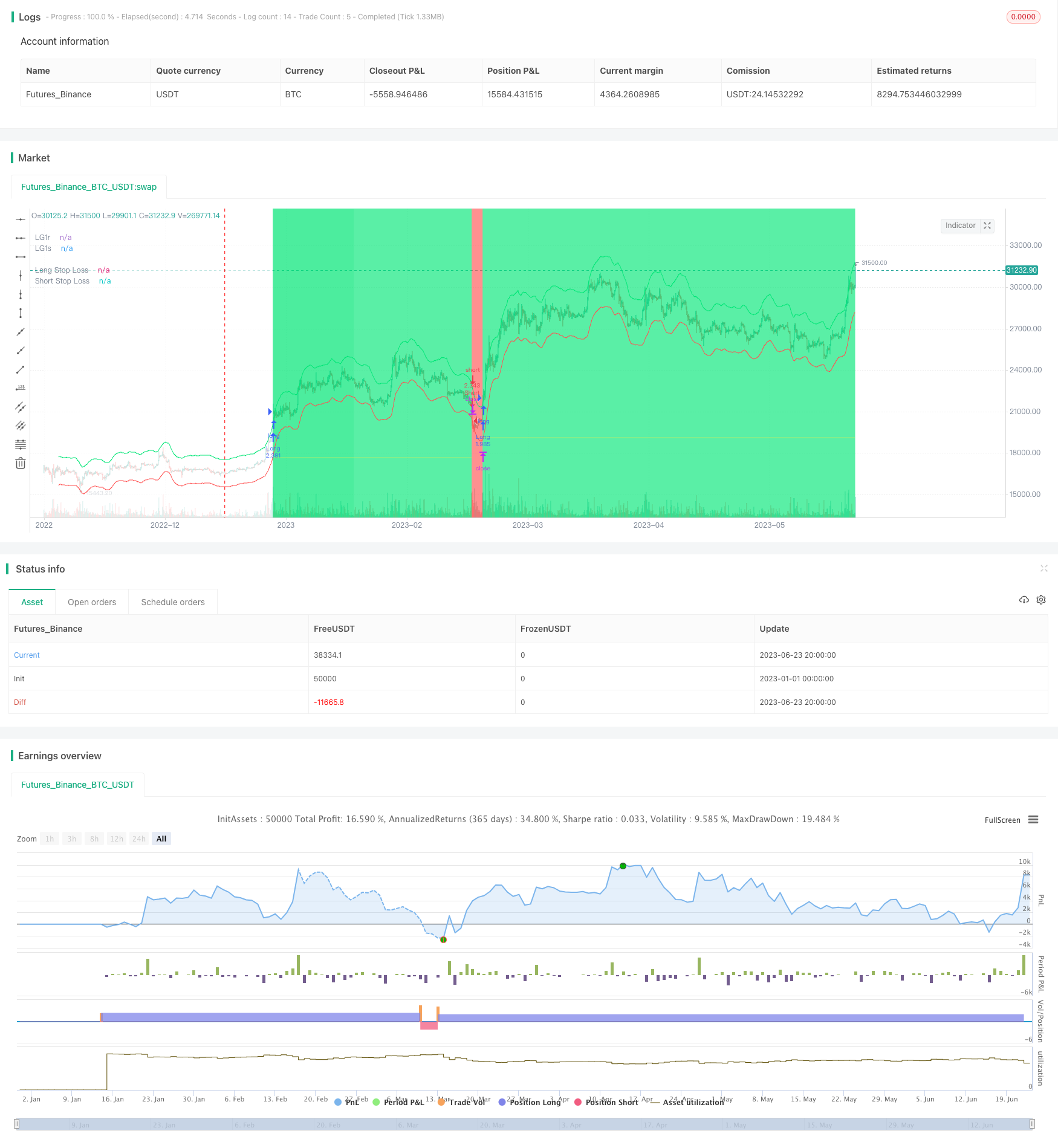
概述
这个策略利用线性回归函数和最小二乘法计算出价格通道,通道由两条绿色和红色线组成。它采用基于近期ATR的动态止损来放置止损单。
策略原理
该策略使用长度为25,平移5的线性回归计算出中心线xLG。然后在中心线上下各取价格的6%做为通道范围,通道上线是xLG1r,通道下线是xLG1s。
当价格高于xLG1r时,做多;当价格低于xLG1s时,做空。并记录最后做多和做空的时间。当最后做多时间大于最后做空时间时产生做多信号;当最后做空时间大于最后做多时间时产生做空信号。
动态ATR止损使用ATR周期1,倍数2来计算。在做多时,止损线为收盘价减去ATR值与倍数的乘积;在做空时,止损线为收盘价加上ATR值与倍数的乘积。
优势分析
- 使用线性回归通道,能跟踪长期趋势
- 基于ATR计算止损,可以动态调整,避免止损过大过小
- 采用价格突破产生信号,可以减少虚假信号
风险及改进
- 线性回归通道参数需要优化,现在的通道范围可能过窄
- ATR倍数也需要测试以获得最佳参数
- 可以考虑在突破时增加确认机制,避免假突破
优化思路
- 测试不同的回归长度周期,找到较优的参数
- 尝试不同的ATR周期和ATR止损倍数
- 在突破信号时,增加额外确认条件,如交易量突破
总结
该策略整合了趋势跟踪、动态止损和突破信号等多种技术指标,形成一个具有较强适应性的趋势跟踪体系。通过优化参数和增加信号过滤,可以进一步增强策略稳定性和盈利能力。该策略可以为量化交易者提供一个非常有价值的思路。
策略源码
/*backtest
start: 2023-01-01 00:00:00
end: 2023-06-24 00:00:00
period: 4h
basePeriod: 15m
exchanges: [{"eid":"Futures_Binance","currency":"BTC_USDT"}]
*/
//@version=4
// Thanks to HPotter for the original code for Center of Gravity Backtest
strategy("Center of Gravity BF 🚀", overlay=true, initial_capital=10000, default_qty_type=strategy.percent_of_equity, default_qty_value=100, commission_type=strategy.commission.percent, commission_value=0.15)
/////////////// Time Frame ///////////////
testStartYear = input(2017, "Backtest Start Year")
testStartMonth = input(1, "Backtest Start Month")
testStartDay = input(1, "Backtest Start Day")
testPeriodStart = timestamp(testStartYear,testStartMonth,testStartDay, 0, 0)
testStopYear = input(2019, "Backtest Stop Year")
testStopMonth = input(12, "Backtest Stop Month")
testStopDay = input(31, "Backtest Stop Day")
testPeriodStop = timestamp(testStopYear,testStopMonth,testStopDay, 0, 0)
testPeriod() => true
///////////// Center of Gravity /////////////
Length = input(25, minval=1)
m = input(5, minval=0)
Percent = input(6, minval=0, title="COG %")
xLG = linreg(close, Length, m)
xLG1r = xLG + ((close * Percent) / 100)
xLG1s = xLG - ((close * Percent) / 100)
pos = 0.0
pos := iff(close > xLG1r, 1, iff(close < xLG1s, -1, nz(pos[1], 0)))
possig = iff(pos == 1, 1, iff(pos == -1, -1, pos))
/////////////// Srategy ///////////////
long = possig == 1
short = possig == -1
last_long = 0.0
last_short = 0.0
last_long := long ? time : nz(last_long[1])
last_short := short ? time : nz(last_short[1])
long_signal = crossover(last_long, last_short)
short_signal = crossover(last_short, last_long)
last_open_long_signal = 0.0
last_open_short_signal = 0.0
last_open_long_signal := long_signal ? open : nz(last_open_long_signal[1])
last_open_short_signal := short_signal ? open : nz(last_open_short_signal[1])
last_long_signal = 0.0
last_short_signal = 0.0
last_long_signal := long_signal ? time : nz(last_long_signal[1])
last_short_signal := short_signal ? time : nz(last_short_signal[1])
in_long_signal = last_long_signal > last_short_signal
in_short_signal = last_short_signal > last_long_signal
last_high = 0.0
last_low = 0.0
last_high := not in_long_signal ? na : in_long_signal and (na(last_high[1]) or high > nz(last_high[1])) ? high : nz(last_high[1])
last_low := not in_short_signal ? na : in_short_signal and (na(last_low[1]) or low < nz(last_low[1])) ? low : nz(last_low[1])
since_longEntry = barssince(last_open_long_signal != last_open_long_signal[1])
since_shortEntry = barssince(last_open_short_signal != last_open_short_signal[1])
/////////////// Dynamic ATR Stop Losses ///////////////
atrLkb = input(1, minval=1, title='ATR Stop Period')
atrMult = input(2, step=0.25, title='ATR Stop Multiplier')
atr1 = atr(atrLkb)
longStop = 0.0
longStop := short_signal ? na : long_signal ? close - (atr1 * atrMult) : longStop[1]
shortStop = 0.0
shortStop := long_signal ? na : short_signal ? close + (atr1 * atrMult) : shortStop[1]
/////////////// Execution ///////////////
if testPeriod()
strategy.entry("Long", strategy.long, when=long)
strategy.entry("Short", strategy.short, when=short)
strategy.exit("Long SL", "Long", stop=longStop, when=since_longEntry > 0)
strategy.exit("Short SL", "Short", stop=shortStop, when=since_shortEntry > 0)
/////////////// Plotting ///////////////
plot(xLG1r, color=color.lime, title="LG1r")
plot(xLG1s, color=color.red, title="LG1s")
plot(strategy.position_size <= 0 ? na : longStop, title="Long Stop Loss", color=color.yellow, style=plot.style_circles, linewidth=1)
plot(strategy.position_size >= 0 ? na : shortStop, title="Short Stop Loss", color=color.orange, style=plot.style_circles, linewidth=1)
bgcolor(strategy.position_size > 0 ? color.lime : strategy.position_size < 0 ? color.red : color.white, transp=90)
bgcolor(long_signal ? color.lime : short_signal ? color.red : na, transp=60)